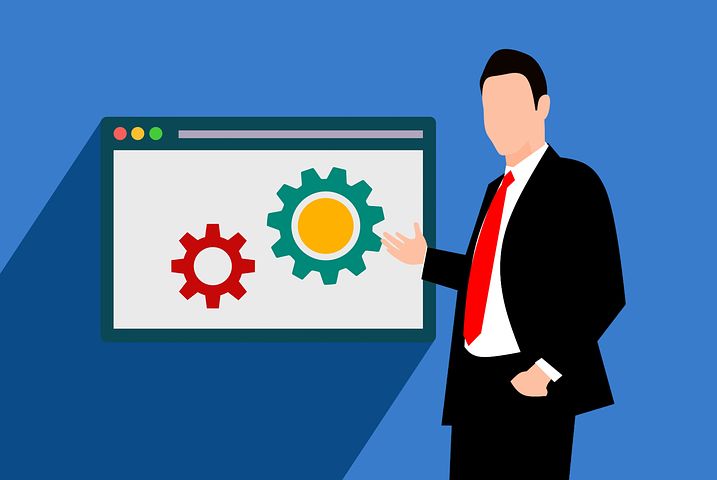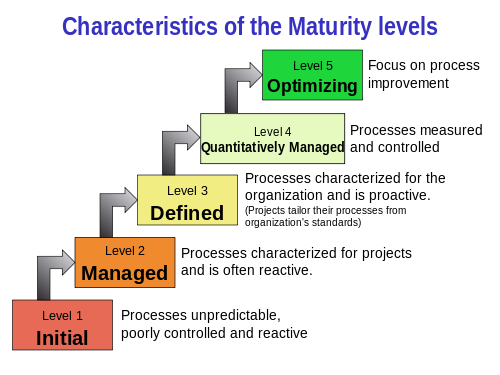This article was written by Bao. P (Alvin).
Introduction
To be able to run a company, manage a group, or control any system, or even have the ability to start a business, you need to understand your capabilities on a scale of 1 – 5 with one being chaotic and 5, a world-class fine-tuned machine. Once you have narrowed down your business functions, you need to consider your company’s performance for each of those functions. From those judgments of your overall capacity, you need to set standards and set goals for yourself and the crew so that you can work together to improve the capabilities that would have the most significant impact on your business. All in all, it may seem like these activities are easy to do, the plans are easy to achieve, but in truth, being able to grow to take your business to the world and maintain a successful business is a long and endless process with various difficulties.
Therefore, entrepreneurs, especially company leaders, need to have a tool to measure and capture the progress of each department to control each person’s work process and performance so that the company can develop systems and processes that can withstand the complexities and precision needed to scale your company. And to make the process of scaling your various functions easier, this article would like to introduce a tool, which is the Capability Maturity Model (CMM).
Table of Contents

What is the Capability Maturity Model?
By now, you are probably wondering what the “Capability Maturity Model” is? The model was essentially created by Watts Humphrey and several other engineers at Software Engineer Institution (SEI) in the mid-1980s (Agile & Scrum Project Management, 2009). As for its definition, according to Upadhyay (2020), the Capability Maturity Model, or CMM for short, is a methodology applied to strengthen and improve a business’s development process of all industries. In other words, it is a practical application that operates based on real-world data for the growth of business processes in various ways (Paulk, 2001), such as IT, software engineer, project management, etc. (Agile & Scrum Project Management, 2009)
In addition, the Capability Maturity Model has a new successor, a more advanced version of it, which is the “Capability Maturity Model Integrated”, in short for CMMI. The description and purpose of CMMI are not much different from its predecessor.
Five maturity levels of CMM
Maturity levels help businesses determine which issues need to be prioritized and addressed first and immediately. This is crucial for software organizations as CMM maturity levels enable them to solve business process intricacies one by one. Before the advent of CMM, corporations often made the mistake of choosing to solve the issues and improve them on their own. Yet they failed, and no problems improved because they realized that the improvement requirements were too complex and overwhelmed by the magnitude of the predicament.
Thanks to Humphrey’s insight, he recognized those struggles. And together with the SEI engineering team, he designed the CMM with five maturity levels to help organizations choose and identify which issues need to be prioritized. As you can see in the picture below, those five levels of maturity are:
- Level 1: Initial
- Level 2: Repeatable
- Level 3: Defined
- Level 4: Quantitatively Managed
- Level 5: Optimizing

Processes at this level are often disorganized, and because of this, problems are often unpredictable and undocumented. Because of that chaos, these software management processes are not qualified for Level 2, so CMM has to put those processes to Level 1 to rearrange the order of the process to avoid chaos. For Initial Level activities to be successful, the problem-solving process requires the efforts of each individual within the group through adequate recording of previous project’s errors.
To make it easier to comprehend the maturity levels, I would like to illustrate them through an example. Imagine that there is an To make it easier for you to comprehend the maturity levels, I would like to illustrate them through an example. Imagine that there is an entrepreneur who is just starting to open an online florist shop in Los Angeles, USA. People will order their flowers online, and the staff will take orders and deliver flowers all day. Since its inception, this businessman has been very excited and worked hard to launch the first batches of products.
However, the initial start-up did not go as smoothly as the businessman thought because 50% of his first shipment was returned. Furthermore, he also received multiple complaints from the customers. Some of the reasons for the return of the load is that their flower is bent, even some parts are broken. In addition, the flower size is a bit small, not suitable for customers, so it was returned. Since this is a relatively new problem for the trader, to improve the product, he begins to note shortcomings that need improvement, such as changes in the size and shape of the flower. In addition, they will also list flower sizes on their website and any new flowers they import will be subject to their standard process. This is Level 1 (Initial Level) – they realize new flaws in their product; hence, the success rate is only 50%.

Repeatable Level
Next comes the second level, the Repeatable Level. Processes at this level focus and check on basic project management processes, such as setting up to manage schedules, costs, etc. Level 2 does not concentrate on dealing with technical processes because these processes are not addressed at Level 1 due to the complexity of the problem; instead, the Repeatable Level only focuses on the basic management processes. At the second level, the success rate of project management processes becomes higher because necessary improvement processes have been recorded based on the successful results of previous similar projects.
Back to the example of the florist in Los Angeles. The florist also needs to rethink essential project management when dealing with their products and improve product sizes. The management process that I want to mention here is about the store’s delivery process. Last time, when delivering products to customers for the first time, in addition to the small size of the flowers, some flowers were bent and broken due to poor flower preservation and delivery. Therefore, he learned from his mistakes and fixed them by changing his staff’s means of delivery to be more spacious and less damaging to the flowers so that his better-designed products could reach customers. And he kept repeating this process over and over again after about four months. This is the second level (Repeatable Level) – they fixed the problem, and now 75% of the flower has consistency.

Defined Level
At Level 3, the Define Level, organizations will typically focus on developing their processes based on organizational standards and the success of the last two stages to speed up problem-solving and maintenance.
After bringing its improved batch of products to market over the next 4 to 6 months, the florist received many compliments, and as a result, profits increased. Therefore, they gradually established a standard of their own. Through customers’ positive reviews, the imported flowers are gorgeous and have a reasonable size, eye-catching colors; the shop takes that as the motivation. As a result, they continue to promote innovation in flower sizes, continue to import a variety of flowers, and improve the delivery process to be both fast and secure. This is Level 3 (Repeatable Level) – they have identified the production problem, and 90% of the flowers are consistent.

Quantitatively Managed Level
From developing their software at Level 3, organizations will begin to collect and control the data of the processes in the software they created at Level 4 (Managed Level). Furthermore, Level 4 concentrates on the company’s product quantitative data and its quality.
After continuing to identify and improve from its mistakes of product development, flower preservation process, and delivery after about eight months, the flower shop collects comments from consumers and manages them so that they can improve the quality of their products more based on the wishes of their customers. In addition, to save more time, they introduced a commenting system on their website for their employee to interact directly with the consumer and quickly identify defects in which parts need to be corrected. This is Level 4 (Quantitatively Managed Level) – they introduced a data system that tells them if there is a defect and which part of the factory they come from, increasing the success rate to 95%.

Optimizing Level
Last but not least is Level 5, the Optimization Level. Here, new software processes are continuously improved based on the results or problems it causes and corrected to fit the organization’s needs.
In the end, thanks to innovation and learning from its mistakes, the store continued to do well and thrived for one year. From receiving online orders, preserving flowers to the delivery process, the systems have all been optimized. Hence, for the success of the flower shop to be maintained forever, the businessman thinks that it is advisable to expand the shop’s capacity so that they can grow not only in Los Angeles but also in many other countries. This is Level 5 (Optimizing Level) – after using these new data systems for one year, they have optimized the fault identification process and have a 99% success rate.
Note to the audience: The author does not know how the florist works, so the percentages above are all fictitious examples, but this story is made to help you understand the stages a business needs to go through.
The benefits and drawbacks of CMM
Everything has its two sides, and the CMM is no exception. The nature of this model has its strengths and flaws. Therefore, corporations should understand the nature of this system to reduce its drawbacks and increase its benefits when using the Capability Maturity Model.
Benefits
- Cost and time-saving.
- Becomes the foundation for serving as a maturity model for other business functions and departments.
- Flexibility for all industries.
First is the time and money-saving strengths of the Capability Maturity Model. CMM-verified improvement processes are often relatively cost-effective because the system is designed to detect defects in improvement processes earlier and more efficiently than other models. Hence, when using the capability maturity model, the costs and time to improve the functions of your enterprises will increase significantly. In addition to the fact that CMM can save you money and time to fix the errors of your company improve business processes, this model can also support you in reducing the sudden change in your production schedules and increase the predictability of contingency costs.
Since the CMM was one of the first models created to improve the process of any industry, it can be seen as the foundation for other mature model creations, such as a later version of CMM (the CMMI) and the Business Capability Maturity Model (BCMM), etc. Therefore, this becomes the second strong point of CMM.
Finally, the CMM is a model that is quite flexible for all markets and processes. If you have a workforce with some practical knowledge that fits any industry, they will utilize the model to fix process errors in all sectors.
Drawbacks
- Just a theoretical model
- Need to have an experienced employee working in a department or company who has gone through all five stages.
Based on the information of Gomes (2013) and his colleagues, the maturity models are considerably widely applied, but it seems that they do not increase the productivity of the firm. He argues that because maturity models are often only based on theory, there is no firm or research paper to prove that firms will succeed when applying maturity models (Gomes et al., 2013). There is no concrete definition between what process is Level 4 and what process is Level 5. Therefore, you will have to use some guesswork or research into other companies to develop a criterion for each level. Still, we hope our stories have provided an example to help you visualize the differences. You will have to define when something transitions from 4 to 5. For example, does all the flower images have to be completely optimized to reach Stage 5 or is 70% enough – that would be your decision.
Additionally, another minor weakness that CMM suffers from is that for the Capability Maturity Model to be used most effectively, businesses need to have a human resource with an appropriate amount of knowledge of each level and specialization of the project processes in which the CMM is operating. Without previous hands-on experience seeing and working in an organization that has gone through all five levels, you do not have a foundation for evaluating what processes are at what level and knowing especially what Levels 4 and 5 look like.
The Capability Maturity Model’s implementation
To implement the Capability Maturity Model, entrepreneurs need to consider the following basic steps:
- Look at your business as a whole.
- Determine the purpose of the corporation and what motivates the business to use the maturity model.
- Identify mistakes of previous projects.
- Break them down and assign them to the appropriate maturity levels. Usually, the problems will be included in two entry maturity levels (Levels 1 and 2).
- Determine which problem should be addressed first, as well as the nature of the problem. If the problem is relatively new and chaotic, these problems need to be included in Level 1 to be resolved. If it is an old problem, put it in Level 2 to go through the same re-examination process.
- Assign human resources with appropriate abilities and knowledge commensurate with maturity levels to resolve problems more quickly.
- Once the problem has been solved at the above two levels, those results need to be transferred to Level 3 so that the development department can start engineering the product for the business to suit the corporation and customers’ requirements.
- After completing the software development stage, the results need to be deployed to the market.
- Level 4 personnel gather results from market product reviews and manage product information and quality.
- Finally, from the comments received, if there is still a defect in the product, then bring it back to Level 1 or 2 to resolve, forming a continuous development cycle of the company (this is Level 5).
Conclusion
In a nutshell, the Capability Maturity Model is a process problem-solving system in all industries that save businesses from dealing with any business process problems. If you still have questions or have problems dealing with product or project processes, please visit our company training program through the following link: https://scalingyourcompany.com. We provide coaching to business owners and help them expand their company revenue from six figures US dollars to seven or even eight-figures.
Reference (most pictures used are from pixabay.com)
Agile & Scrum Project Management. (2009). Capability Maturity Model (CMM): Brief history and applications in Agile Project Management. https://www.brighthubpm.com/agile/56412-capability-maturity-models-history-of-the-cmm/.
Gomes, J., Cadeira, M. & Romao, M. (2013). Linking benefits to the maturity model. https://www.researchgate.net/publication/236577092.
Paulk, M.C. (2001). A history of the Capability Maturity Model for software. Carnegie Mellon University. https://citeseerx.ist.psu.edu/viewdoc/download?rep=rep1&type=pdf&doi=10.1.1.216.199.
Upadhyay, R.K. (2020). Levels of Capability Maturity Model (CMM). https://www.geeksforgeeks.org/levels-of-capability-maturity-model-cmm/.



